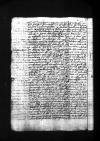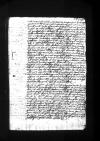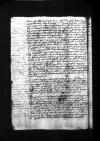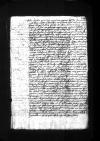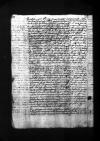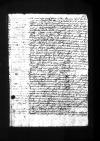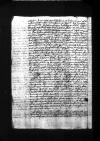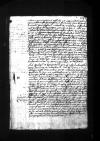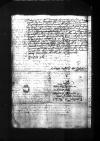Quod ad ⌊⌋ Dominationis Vestrae Reverendissimae XIX Augusti praeteriti ad me datas hucusque non responderim, causa fuit in primis, quod convenire me prius oportuit cum amicis meis, ⌊domino castellano Gdanensi⌋ et capitaneo Novensi domino ⌊Ioanne a Werden⌋, ad quem Dominatio Vestra Reverendissima in negotio Warm(iensi) ad tractandum cum ⌊domino Gisio⌋ scripserat, convenimusque paulo ante his post ⌊conventum Novoforensem⌋, cum reverendissimus dominus ⌊episcopus Camenecensis⌋ apud me ageret et cum diffuse inter nos de omnibus contulissemus et nullum non in eo negotio movissemus lapidem, invenimus institutum nostrum transigi non posse absque scientia et consensu ⌊reverendissimi domini Varmiensis⌋, cui quamvis durus est iste sermo neque uno ictu arbor haec sterni potest, cognoscentes eius ingenium et in eo, quod semel in animum admisit, tenacitatem, visum nobis fuit commodius et consultius, quod ⌊serenissima maiestas regia⌋ illi iterum scriberet eum in modum, ut ex scheda his inclusa Dominatio Vestra Reverendissima accipiet utque Dominationi Vestrae Reverendissimae maiestas regia rursus committeret tractare per dominum Ioannem a Werden cum illo, quo ei modis, quibus posset melioribus et rationibus his temporibus convenientibus persuaderet, ut in me consentiret. Dominus ⌊Gisius⌋, modo sic fieret et voluntatem et propensionem suam, immo et omne adminiculum, quod praestare potest, contentus mihi succedere pollicetur, ob idque dominus ⌊Ioannes a Werden⌋ litteras Dominationis Vestrae Reverendissimae non reddidit domino Gisio, ut postea alias a Dominatione Vestra Reverendissima ad eos tractatus aptas acciperet. In ea sententia et sub his rationibus, quae ipsis amicis meis ad institutum perficiendum melius videbantur expedire, confeci litterarum exempla a ⌊serenissima maiestate regia⌋ scribendarum ad ⌊reverendissimum dominum Varmiensem⌋ et eius ⌊capitulum⌋ et huius rei tractatorem ad dominum ⌊Ioannem a Werden⌋, quemadmodum Dominatio Vestra Reverendissima ex adiunctis videbit, misique illa ad ⌊reverendissimum dominum Premissliensem⌋ et per litteras serenissimae maiestati regiae supplicavi, cum iam maiestas eius consensisset, quod Dominatio Vestra Reverendissima hoc negotium tractare posset, quo citius in effectum perduceretur, ut clementer annueret istiusmodi scribi litteras atque denuo hanc tractationem Dominationi  BNW, BOZ, 2053, TG 17, No. 2063, f. 164v Vestrae Reverendissimae iniungeret expectavique hucusque responsum et haec potissima fuit causa, ut de omnibus Dominationem Vestram Reverendissimam plane certiorem reddere possem, quod scribere hactenus distulerim.
BNW, BOZ, 2053, TG 17, No. 2063, f. 164v Vestrae Reverendissimae iniungeret expectavique hucusque responsum et haec potissima fuit causa, ut de omnibus Dominationem Vestram Reverendissimam plane certiorem reddere possem, quod scribere hactenus distulerim.
Rediitque paulo ante nuntius, qui hoc mihi rettulit responsum, ut ex copia ⌊⌋ ⌊reverendissimi domini Premisliensis⌋ ad me Dominatio Vestra Reverendissima intelliget. Permovit ⌊maiestatem eius⌋, ut ex rescripto ⌊reverendissimi domini Premisliensis⌋ liquet, quod iterum ⌊reverendissimum dominum Varmiensem⌋, si ad hunc pro me modum scriberet, molestare contra promissum sibi videretur, cum tamen salubris admonitio dici molestatio non debeat. Et nisi ea in re de mente ⌊serenissimae maiestatis regiae⌋ ⌊reverendissimus dominus Varmiensis⌋ commoneatur, nihil ab eo obtinebitur, adeo ne coadiutorem admittat on the margin⌈admittatadmittat on the margin⌉, in animum induxit. Consuluerunt igitur dominus ⌊castellanus Gdanensis⌋ et dominus ⌊Ioannes a Werden⌋, qui affinis eius est, et penitius ingenium et mores eius noverunt, ut per hunc modum ad consentiendum a ⌊serenissima maiestate regia⌋ induceretur habitisque huiusmodi litteris certo arbitratur se negotium hoc apud ⌊dominum Varmiensem⌋ confecturum, quasi ex instructione Dominationis Vestrae Reverendissimae, quam sibi ex re et tempore in congressu cum domino Varmiensi esset formaturus, polliceturque se nihil acturum cum indignitate aut offensione serenissimae maiestatis regiae vel contra Reverendissimae Dominationis Vestrae voluntatem. Tantum abest, quod merito ⌊serenissima maiestas regia⌋ ferre non posset aut vellet, ut dominus ⌊Ioannes a Werden⌋ ex instructione Dominationis Vestrae Reverendissimae maiestatis suae nomine quippiam ageret. Iste modus visus est mihi ex persuasione horum amicorum meorum expeditior ad tractandum cum ⌊reverendissimo domino Varmiensi⌋, cuius habito consensu, facilis cum ⌊capitulo⌋ et facilior cum ⌊domino Gisio⌋ erit transactio etc. Ecclesia haec Varmiensis sic se gessit semper et observavit studiosissime, ne quem regium aut in curia et aula nostra versatum sibi praeficeret, quod si in hoc tractatu non perfringetur, deinceps in hoc instituto diu manebit libera, unde ut nunc sunt tempora, quid ⌊Regno⌋ incommodi accidere posset, facilis est coniectura. Ego quidem nihil ambio amplius neque cum Romano pontifice paupertatem hanc meam laetam et honestam commutare velim. Plus mihi a Deo datum est, quod vel merui, vel umquam mereri possim, adigit tamen me ad hanc ambitionem fides mea et amoris observantia erga ⌊principes meos⌋ ⌊Regnumque⌋ et dominia eorum et quod Deo duce nemo hic superinscribed⌈hichic superinscribed⌉ me fidelius serenissimis principibus meis et domi BNW, BOZ, 2053, TG 17, No. 2063, f. 165rniis eorum inserviendi voluntatem et propensionem habere possit superinscribed⌈possitpossit superinscribed⌉, quamvis longe secus calumniatores mei, qui ne nomine quidem noti mihi esse audent, falsissime contra me pronuntiaverint et nihil docuerint, nihilominus contra me creditum est quicquid fuit delatum et cum iam nebulae istae per solem veritatis, quae temporis est filia, sint repressae et nihil contra me probari potuerit falsosque fuisse delatores iam compertum habeatur, quo tamen adhuc deliquisse videar, impingitur mihi, ut ex litterarum ad me exemplo ⌊serenisimae reginalis maiestatis⌋ patebit, quod sim conquestus et bono animo admonitiones mihi factas non susceperim, quae quales fuerint, non sunt Dominationi Vestrae Reverendissimae incognitae. Durum quidem est tacere, cum doleas et in ipso cruciatu comprimere gemitum, ego tamen sic mihi temperavi, ut non de ⌊reginali maiestate⌋, sed de his, qui me iniquissime perstrinxerant, amicis aliquando conquestus sim et innocentiam meam aperuerim. Sic habet cf. Phaed. I 1 ⌊fabella de ove, quae lupo videbatur adverso flumine turbare aquamcf. Phaed. I 1 ⌋. Ferendum est, quod mutare non possumus. Hinc fortassis fit, quod ⌊serenissima maiestas regia⌋ in rem meam redditur difficilior, fieri enim non potest, quamdiu indignatio haec contra me concepta scintillat, quin fortunis meis modis omnibus obex ponatur, qui tamen contra divinam voluntatem, cui me totum tradidi et commisi, obstare non poterit, illa, quod reliquum est, pro me perficiet et non permittet me ludibrio fieri stolidis et impiis hominibus, sibi, quod Dei est, tribuentibus etc.
BNW, BOZ, 2053, TG 17, No. 2063, f. 165rniis eorum inserviendi voluntatem et propensionem habere possit superinscribed⌈possitpossit superinscribed⌉, quamvis longe secus calumniatores mei, qui ne nomine quidem noti mihi esse audent, falsissime contra me pronuntiaverint et nihil docuerint, nihilominus contra me creditum est quicquid fuit delatum et cum iam nebulae istae per solem veritatis, quae temporis est filia, sint repressae et nihil contra me probari potuerit falsosque fuisse delatores iam compertum habeatur, quo tamen adhuc deliquisse videar, impingitur mihi, ut ex litterarum ad me exemplo ⌊serenisimae reginalis maiestatis⌋ patebit, quod sim conquestus et bono animo admonitiones mihi factas non susceperim, quae quales fuerint, non sunt Dominationi Vestrae Reverendissimae incognitae. Durum quidem est tacere, cum doleas et in ipso cruciatu comprimere gemitum, ego tamen sic mihi temperavi, ut non de ⌊reginali maiestate⌋, sed de his, qui me iniquissime perstrinxerant, amicis aliquando conquestus sim et innocentiam meam aperuerim. Sic habet cf. Phaed. I 1 ⌊fabella de ove, quae lupo videbatur adverso flumine turbare aquamcf. Phaed. I 1 ⌋. Ferendum est, quod mutare non possumus. Hinc fortassis fit, quod ⌊serenissima maiestas regia⌋ in rem meam redditur difficilior, fieri enim non potest, quamdiu indignatio haec contra me concepta scintillat, quin fortunis meis modis omnibus obex ponatur, qui tamen contra divinam voluntatem, cui me totum tradidi et commisi, obstare non poterit, illa, quod reliquum est, pro me perficiet et non permittet me ludibrio fieri stolidis et impiis hominibus, sibi, quod Dei est, tribuentibus etc.
Quod Dominatio Vestra Reverendissima ascensum meum et res meas tanta benevolentia et cura prosequitur litterasque ad dominum ⌊Ioannem a Werden⌋ et ad ⌊dominum Gisium⌋ dederit, numquam gratias satis dignas habere possum, quas tamen tenuitas mea potest, habeo, verum cum et dominus Gisius sic consuluerit, ut de mente regia a Dominatione Vestra Reverendissima per dominum Ioannem a Werden cum ⌊reverendissimo domino Varmiensi⌋, ut in me consentiat, tractetur, quantum possum impensius oro, Dominatio Vestra Reverendissima non velit gravari in omnem eventum adhuc temptare, si istiusmodi litterae, ut in schedis adiunctis exempla habentur, a ⌊serenissima maiestate regia⌋ impetrari possint. ⌊Reverendissimus dominus Premisliensis⌋ non omnem ademit spem, quod si Dominationis Vestrae Reverendissimae suffragium accesserit, bene sperare non desinam et cum successerit, Deo in primis omnia et Dominationi Vestrae Reverendissimae accepta referam, quodque opera Dominationis Vestrae Reverendissimae feliciter est superinscribed⌈estest superinscribed⌉ coeptum, optatum dabit exitum etc.  BNW, BOZ, 2053, TG 17, No. 2063, f. 165v Non aegreferat, quaeso, Dominatio Vestra Reverendissima consilium hoc amicorum meorum et meum, de quo ⌊⌋ IIIa Iunii praeteriti, mutatum esse, cum enim cognoveramus sine scientia ⌊reverendissimi domini Varmiensis⌋ ea in re nihil posse perfici, et si tractatus hi nostri in notitiam eius pervenissent, graviter animum eius offendi, quod se excluso, ista a nobis agerentur, consultius visum fuit nobis, ut via regia ad eum ingrederemur. Quod si igitur ⌊serenissima maiestas regia⌋ induci posset, ut istiusmodi litteris, ut sunt exempla, desiderium et postulationem suam serio ⌊reverendissimo domino Varmiensi⌋ declararet, sperare possemus rem esse in portu certoque putat dominus ⌊Ioannes a Werden⌋ mentem eius, quantumvis immobilem, si tales darentur litterae, flecti posse; ⌊dominum Gisium⌋, quem iam in sententiam suam traxit, ad eam expugnationem se dicit dominus Ioannes habere adiutorem. De condicionibus ⌊reverendissimo domino Varmiensi⌋ proponendis hanc dicit esse non postremam, ut nomine meo promittat me nihil ex bonis aut proventibus, quamdiu in vivis est, quae ad ecclesiam et mensam episcopalem spectant, exacturum nihilque esse, quod magis vereatur, quam si coadiutorem assumeret, ne illi partem aliquam proventuum impartiri cogeretur cumque ex eo se immunem cognoscet, faciliorem ad omnia fieri etc. Eo in cardine res haec volvitur et omnis spes in Domino Deo est, cui si visum fuerit, Dominationi Vestrae Reverendissimae suggeret, quae facto sunt opus et quod misericordiae eius placuerit, per Dominationem Vestram Reverendissimam perficiet.
BNW, BOZ, 2053, TG 17, No. 2063, f. 165v Non aegreferat, quaeso, Dominatio Vestra Reverendissima consilium hoc amicorum meorum et meum, de quo ⌊⌋ IIIa Iunii praeteriti, mutatum esse, cum enim cognoveramus sine scientia ⌊reverendissimi domini Varmiensis⌋ ea in re nihil posse perfici, et si tractatus hi nostri in notitiam eius pervenissent, graviter animum eius offendi, quod se excluso, ista a nobis agerentur, consultius visum fuit nobis, ut via regia ad eum ingrederemur. Quod si igitur ⌊serenissima maiestas regia⌋ induci posset, ut istiusmodi litteris, ut sunt exempla, desiderium et postulationem suam serio ⌊reverendissimo domino Varmiensi⌋ declararet, sperare possemus rem esse in portu certoque putat dominus ⌊Ioannes a Werden⌋ mentem eius, quantumvis immobilem, si tales darentur litterae, flecti posse; ⌊dominum Gisium⌋, quem iam in sententiam suam traxit, ad eam expugnationem se dicit dominus Ioannes habere adiutorem. De condicionibus ⌊reverendissimo domino Varmiensi⌋ proponendis hanc dicit esse non postremam, ut nomine meo promittat me nihil ex bonis aut proventibus, quamdiu in vivis est, quae ad ecclesiam et mensam episcopalem spectant, exacturum nihilque esse, quod magis vereatur, quam si coadiutorem assumeret, ne illi partem aliquam proventuum impartiri cogeretur cumque ex eo se immunem cognoscet, faciliorem ad omnia fieri etc. Eo in cardine res haec volvitur et omnis spes in Domino Deo est, cui si visum fuerit, Dominationi Vestrae Reverendissimae suggeret, quae facto sunt opus et quod misericordiae eius placuerit, per Dominationem Vestram Reverendissimam perficiet.
Quanto maerore adversa valetudo Dominationis Vestrae Reverendissimae me et omnes ⌊dominos harum terrarum consiliarios⌋ affecerit, neque dici neque scribi potest. Domino Deo sit honor laus et gloria atque omnis gratiarum actio, qui tandem Dominationem Vestram Reverendissimam nobis restituit, humillimeque divinae maiestati eius supplico, ut illam pro salute ⌊rei publicae Regni et nostrae⌋ proque omnium bonorum consolatione quam diutissime nobis incolumem conservet. Benevolentiam et propensionem Dominationis Vestrae Reverendissimae, quam erga me et omnes ⌊harum terrarum consiliarios⌋ in novissimis suis litteris declaravit, in consilio ⌊conventus praeteriti Novoforensis⌋ exposui omnibus et praesertim oblationem Dominationis Vestrae Reverendissimae in negotio, quod nobis est cum ⌊domino Costka⌋, quae tam nobis omnibus grata fuit, ut nihil esse potuerit gratius. Scripserunt itaque ex eo ⌊conventu⌋ ⌊domini consiliarii⌋ Dominationi Vestrae Reverendissimae, quas litteras his addidi. Ex illis cognoscet, quid a ⌊serenissima maiestate regia⌋ per Dominationem Vestram Reverendissimam sibi impetrari petunt et quid in negotio ⌊domini Coscze⌋ fieri velint, se omnes Dominationi Vestrae Reverendissimae plurimum commendantes.
 BNW, BOZ, 2053, TG 17, No. 2063, f. 166r
BNW, BOZ, 2053, TG 17, No. 2063, f. 166r
His diebus, cum ⌊hic⌋ apud me ageret ⌊reverendissimus dominus Camenecensis⌋, intellexi nescio quae adhuc in curia nostra contra me circumferri et cum iam a duobus et ultra annis in curia nostra visus non sim et plerique nescio quam metamorphosim in me factam esse putant existimantque totum me esse alium, quam prius fuerim, aliamque et mentem et mores me induisse, potissimum cum adhuc ⌊serenissima reginalis maiestas⌋ non omnem contra me deposuerit indignationem novamque occasionem quaerat, quasi de illa conquestus sim, ut merito mihi succensere videri possit, quod plus coniectura, quam ut est, assequitur. Scripsi ⌊maiestati eius⌋ et quibusdam aliis dominis et amicis in curia explorando, an ferri posset adventus meus, quo innocentiam et candorem meum manifestiorem et calumniatores meos mendaces facerem ipsamque reginalem maiestatem omni indignatione et suspicione abstersa, coram mihi reconciliarem. ⌊Quae⌋ per ⌊reverendissimum dominum Premisliensem⌋ mihi respondit, tamen sine fastidio liberum mihi esse neque displiciturum, si venire velim aut manere vel praestolari reditum in ⌊Regnum⌋ seque in eo mihi nolle praescribere, subiungendo, quicquid ea in re vel voluntatis vel mandatis ⌊serenissimae maiestatis regiae⌋ fuerit, sibi quoque id ipsum placere. Sacra item ⌊maiestas regia⌋ idem arbitrio et voluntati meae permisit. Porro ⌊reverendissimus dominus Premisliensis⌋, cum nemo me accusat, ut me per adventum meum purgem, non admodum necessarium esse arbitratur, itidem et alii praeter dominum secretarium ⌊Ludovicum Aliphium⌋ amici consulunt. Addidit tamen ioco ⌊dominus Premisliensis⌋, quod si pecuniae hic in otio et quiete per me non parvo numero congestae me exstimulaverint, me gratum omnibus venturum hospitem. Ego revera, mi Reverendissime et Colendissime Domine, numquam fui uno eodemque tempore ditior et pauperior, si tamen necessitas fidei et honoris mei defendendi exigeret, invenirem ad eam profectionem apud amicos viaticum, cum autem nemo est omnium calumniatorum et delatorum meorum, qui mihi notus esse velit, vel audeat omnesque conticuerunt praeter illos, ut serenissima ⌊reginalis maiestas⌋ scribit, qui fortassis me detulerunt, quod coram multis cuiusdam solacii loco de maiestate eius sim conquestus, non video, cur hoc duro tempore tam longam profectionem inire et tam graves expensas cum magna rerum mearum iactura facere debeam. Nihilo tamen secius Dominationis Vestrae Reverendissimae peto consilium, quod sequi statui.
 BNW, BOZ, 2053, TG 17, No. 2063, f. 166v
Rediit nuper illustrissimus dominus ⌊dux Prussiae⌋ ex congressu cum ⌊filio seniore Ioachimo⌋ illustrissimi ⌊marchionis Brandeburgensis electoris⌋, rebus ex sententia confectis, quemadmodum, ut certo scio, Dominationi Vestrae Reverendissimae scripsit. ⌊⌋ item et mihi manu sua, quarum litterarum his iunxi exemplum, ex quo et illa, quae expedivit, et quaedam alia Dominatio Vestra Reverendissima intelleget. Mitto etiam ad vivum ipsius ⌊illustrissimi Ioachimi filii marchionis⌋ effigiem et neptis ⌊serenissimi regis nostri⌋ ⌊coniugis eius⌋ nuper mortuae ad vivum, inquam, expressam. His simulacris propter alia, quae plurimorum principum habeo plurima, cum gravate caream, libenter tamen Dominationi Vestrae Reverendissimae do, ut a ⌊serenissima maiestate regia⌋ et illis, quibus ingrata non erunt, videantur. Mitto praeterea exempla litterarum ad me nuper ex curia ⌊caesareae maiestatis⌋ datarum, in primis ab illustri ⌊domino de Nassau⌋, a ⌊domino Perrenoto domino de Granvella⌋ pro magno cancellario caesareae maiestatis et a domino doctore ⌊Mathia Held⌋ vicecancellario ⌊Imperii⌋ in curia maiestatis caesareae, ex quibus intelleget, quae fortassis etiam ad intercessionem meam in negotio banni acta sunt et ad quot annos illud sit suspensum etc.
BNW, BOZ, 2053, TG 17, No. 2063, f. 166v
Rediit nuper illustrissimus dominus ⌊dux Prussiae⌋ ex congressu cum ⌊filio seniore Ioachimo⌋ illustrissimi ⌊marchionis Brandeburgensis electoris⌋, rebus ex sententia confectis, quemadmodum, ut certo scio, Dominationi Vestrae Reverendissimae scripsit. ⌊⌋ item et mihi manu sua, quarum litterarum his iunxi exemplum, ex quo et illa, quae expedivit, et quaedam alia Dominatio Vestra Reverendissima intelleget. Mitto etiam ad vivum ipsius ⌊illustrissimi Ioachimi filii marchionis⌋ effigiem et neptis ⌊serenissimi regis nostri⌋ ⌊coniugis eius⌋ nuper mortuae ad vivum, inquam, expressam. His simulacris propter alia, quae plurimorum principum habeo plurima, cum gravate caream, libenter tamen Dominationi Vestrae Reverendissimae do, ut a ⌊serenissima maiestate regia⌋ et illis, quibus ingrata non erunt, videantur. Mitto praeterea exempla litterarum ad me nuper ex curia ⌊caesareae maiestatis⌋ datarum, in primis ab illustri ⌊domino de Nassau⌋, a ⌊domino Perrenoto domino de Granvella⌋ pro magno cancellario caesareae maiestatis et a domino doctore ⌊Mathia Held⌋ vicecancellario ⌊Imperii⌋ in curia maiestatis caesareae, ex quibus intelleget, quae fortassis etiam ad intercessionem meam in negotio banni acta sunt et ad quot annos illud sit suspensum etc.
Quae ⌊Holsatiae dux⌋ cum ⌊Lubecensibus⌋ egit et quae foedera, non satis regi decora, ⌊rex Angliae⌋ contra ecclesiae et sanctorum patrum constitutiones cum Lubecensibus pepigit et alia omnia, quae in illis se obtulerunt partibus, descripta, Dominationi Vestrae Reverendissimae mitto plurimumque rogo, velit non gravari foedera illa regis Angliae et articulos illorum diligenter perlegere et pro sua prudentia apud se accurate reputare. Quod si ⌊Daniae regnum⌋ ⌊regi Angliae⌋ adeo diviti et potenti permittetur, qualem habituri sumus vicinum, non est obscurum verendumque esset, ne his periculosis temporibus, cum aperte Luteranismo laboret, omnem oram ⌊maris nostri⌋ eadem lue infectam usque ad ⌊Vistulae⌋ ostia occuparet. Meminit, ut reor, Dominatio Vestra Reverendissima ea, quae in novissimis de ⌊conterraneis meis⌋ perscripsi. Adnitendum igitur omnibus modis censerem, ut ⌊Holsatiae ducem⌋ viribus, quibus possemus, iuvaremus, ne tam potentem regem (omnis potentia suspecta esse solet) propinquiorem nobis fieri admitteremus.
Ex ⌊Hispania⌋ mihi scribitur ⌊caesarem⌋ validam parasse classem, cum qua multi proficiscuntur aulici, versus terram ⌊Novae Indiae⌋, quae nomen habet ⌊Peru⌋, ubi tanta  BNW, BOZ, 2053, TG 17, No. 2063, f. 167r vis auri esse perhibetur, quanta stanni apud ⌊Britannos⌋, et in propinquo flumen quoddam ⌊Rio de Plata⌋ vocatum, in eius ripis immensa argenti reperitur copia. Mirabilia sua nostri tempore Deus profert. Pestis grassatur in ⌊regno Castiliae⌋, unde ad loca tutiora ⌊caesar⌋ cum aula se contulit. ⌊Imperatrix⌋ abortivit fetum masculum. ⌊Caesar⌋ in ludo taurorum, qui in ⌊Hispaniis⌋ frequens est, in summo fuit periculo, cornibus a bove in terram cum equo deiectus. Dominus ⌊comes de Nassau⌋, postquam mihi ⌊⌋, a ⌊caesare⌋ ad ⌊Belgas⌋ ultimosque hominum Morinos, quos ⌊Flandros⌋ vocamus, missus est, ut nescio quae in his partibus molimina ⌊regis Gallorum⌋ antevertat. cf. Verg. A. IV 373 ⌊Nusquam tuta fidescf. Verg. A. IV 373 ⌋. ⌊Cornelius meus Scepperus⌋ conqueritur toxicum sibi datum, nescius, si ⌊Constantinopoli⌋ aut in ⌊Hungaria⌋, profectus his diebus languens ad domum et ⌊coniugem⌋ suam ⌊Brugas⌋. Tale ex duris et longinquis legationibus pro meritis aut indignatio aut mors solet esse praemium etc. Quae in ⌊Italia⌋ et ⌊Hungaria⌋ et quae acta sunt cum dominis Boemis, quaeso Dominatio Vestra Reverendissima ad me perscribi iubeat. Raro ex his partibus, quae vera sunt, ad nos perferuntur.
BNW, BOZ, 2053, TG 17, No. 2063, f. 167r vis auri esse perhibetur, quanta stanni apud ⌊Britannos⌋, et in propinquo flumen quoddam ⌊Rio de Plata⌋ vocatum, in eius ripis immensa argenti reperitur copia. Mirabilia sua nostri tempore Deus profert. Pestis grassatur in ⌊regno Castiliae⌋, unde ad loca tutiora ⌊caesar⌋ cum aula se contulit. ⌊Imperatrix⌋ abortivit fetum masculum. ⌊Caesar⌋ in ludo taurorum, qui in ⌊Hispaniis⌋ frequens est, in summo fuit periculo, cornibus a bove in terram cum equo deiectus. Dominus ⌊comes de Nassau⌋, postquam mihi ⌊⌋, a ⌊caesare⌋ ad ⌊Belgas⌋ ultimosque hominum Morinos, quos ⌊Flandros⌋ vocamus, missus est, ut nescio quae in his partibus molimina ⌊regis Gallorum⌋ antevertat. cf. Verg. A. IV 373 ⌊Nusquam tuta fidescf. Verg. A. IV 373 ⌋. ⌊Cornelius meus Scepperus⌋ conqueritur toxicum sibi datum, nescius, si ⌊Constantinopoli⌋ aut in ⌊Hungaria⌋, profectus his diebus languens ad domum et ⌊coniugem⌋ suam ⌊Brugas⌋. Tale ex duris et longinquis legationibus pro meritis aut indignatio aut mors solet esse praemium etc. Quae in ⌊Italia⌋ et ⌊Hungaria⌋ et quae acta sunt cum dominis Boemis, quaeso Dominatio Vestra Reverendissima ad me perscribi iubeat. Raro ex his partibus, quae vera sunt, ad nos perferuntur.
Generosus dominus ⌊castellanus Culmensis Dzyalinski⌋ in ⌊conventu⌋ praeterito Novoforensi non gravate mecum in gratiam rediit, utpote qui numquam tantillum iustae causae habuerit, ob quod reditus in gratiam mecum fuisset necessarius. Passiones et affectus hominum sunt varii, quibus cum et ille temperare sibi non potuit, ut istius staturae natura fert, facile omnes offensas ex animo remisi meumque, quod potui, adminiculum praestiti cum aliis dominis, quod ⌊serenissima maiestas regia⌋ consenserit ei ⌊Bratianense castrum⌋ cum his, quae ad illud spectant, redimere sicque mihi erit quam prius vicinior et, ni fallar, magis amicus. Excusationem vero adulterii (sed haec Dominationi Vestrae Reverendissimae in aurem) satis adfert ridiculam, ⌊coniugem videlicet suam⌋ in congressu abs se calculo infici et ideo continere ab ea solere. Mirum, quod paelex non inficiatur etc.
Cum haec scriberem, rediit nuntius meus ex ⌊Gdano⌋ et has adiunctas a domino ⌊Ioanne a Werden⌋, Dominationi Vestrae Reverendissimae inscriptas,  BNW, BOZ, 2053, TG 17, No. 2063, f. 167v attulit. Pax inter ⌊ducem Holsatiae⌋ et ⌊Lubecenses⌋, qui ad eam, multis acceptis damnis, tandem compulsi sunt, his mediis est confecta, quod Lubecenses duci restituere debent castrum et quae ad illud attinent, ⌊Trittaw⌋ dictum et aliud ⌊Lwtin(!)⌋, ⌊episcopo Lubecensi⌋ ademptum, praeterea omnes captivos, quos in hoc bello ceperunt. ⌊Dux⌋ vicissim ⌊illis⌋ reddit naves nuper receptas una cum captivis, praeter ducenta tormenta parva et magna, quae duci sunt a compositoribus adiudicata. Haec pax inter ⌊ducem Holsatiae⌋, quantum ad ⌊Holsatiae dumtaxat ducatum⌋ et inter ⌊Lubecenses⌋ et eorum dominia, debet esse perpetua, excluso bello, quod a duce eiusque confoederatis, ⌊rege Sueciae⌋ et aliis pro ⌊Daniae regno⌋ geritur, quod in suo manet furore. In eo liberum utrisque ⌊duci⌋ et ⌊Lubecensibus⌋ relinquitur fortunae experiri aleam. Reservaverunt sibi etiam ⌊Lubecenses⌋, ut possint liberare ⌊regem Christiernum⌋, si adhuc in vivis est, captivum, non tamen ultra ⌊castrum Sundersborch⌋ illum quaerere debent et deinceps nullos mercennarios milites, si Christiernus rex decessit aut ab eo castro abductus est, per ⌊ducatum Holsatiae⌋ ducere vel duci permittere possunt, tamen ⌊comiti de Oldenborch⌋, qui in ⌊Dania⌋ agit, ferre suppetias, unde illi sex vexilla peditum sub ductoribus quibusdam ⌊Wullenwefer⌋ et ⌊Marco⌋, qui istos Lubeci tumultus excitarunt, miserunt et hoc eo praetextu, ne illi duo superinscribed⌈duoduo superinscribed⌉ rerum turbatores redeant. ⌊Plebs Lubecensis⌋ iam tum demum oculos aperuit et magistratum eiectum restituit atque sexaginta illos viros ex plebe, apud quos erat summa rerum, exauctoravit estque is nunc ⌊Lubeci⌋ ordo, quod fuit fuit in re publica ante 40 annos. Ceterum ⌊dux Holsatiae⌋ contra ⌊comitem de Oldenborch⌋ cum XVII vexillis electorum peditum et cum mille equitibus mercennariis praeter ⌊nobilitatem domesticam⌋ ingressus est potiorem partem ⌊Daniae⌋, quae ⌊Gutthia⌋ dicitur, a qua etiam prius in regem est assumptus etc. Quis huius belli erit exitus et an se ⌊rex Angliae⌋ iuxta pacta cum ⌊Lubecensibus⌋ his turbis immiscet ac uter illorum rex in ⌊Dania⌋ futurus est, successus et tempus docebit.
BNW, BOZ, 2053, TG 17, No. 2063, f. 167v attulit. Pax inter ⌊ducem Holsatiae⌋ et ⌊Lubecenses⌋, qui ad eam, multis acceptis damnis, tandem compulsi sunt, his mediis est confecta, quod Lubecenses duci restituere debent castrum et quae ad illud attinent, ⌊Trittaw⌋ dictum et aliud ⌊Lwtin(!)⌋, ⌊episcopo Lubecensi⌋ ademptum, praeterea omnes captivos, quos in hoc bello ceperunt. ⌊Dux⌋ vicissim ⌊illis⌋ reddit naves nuper receptas una cum captivis, praeter ducenta tormenta parva et magna, quae duci sunt a compositoribus adiudicata. Haec pax inter ⌊ducem Holsatiae⌋, quantum ad ⌊Holsatiae dumtaxat ducatum⌋ et inter ⌊Lubecenses⌋ et eorum dominia, debet esse perpetua, excluso bello, quod a duce eiusque confoederatis, ⌊rege Sueciae⌋ et aliis pro ⌊Daniae regno⌋ geritur, quod in suo manet furore. In eo liberum utrisque ⌊duci⌋ et ⌊Lubecensibus⌋ relinquitur fortunae experiri aleam. Reservaverunt sibi etiam ⌊Lubecenses⌋, ut possint liberare ⌊regem Christiernum⌋, si adhuc in vivis est, captivum, non tamen ultra ⌊castrum Sundersborch⌋ illum quaerere debent et deinceps nullos mercennarios milites, si Christiernus rex decessit aut ab eo castro abductus est, per ⌊ducatum Holsatiae⌋ ducere vel duci permittere possunt, tamen ⌊comiti de Oldenborch⌋, qui in ⌊Dania⌋ agit, ferre suppetias, unde illi sex vexilla peditum sub ductoribus quibusdam ⌊Wullenwefer⌋ et ⌊Marco⌋, qui istos Lubeci tumultus excitarunt, miserunt et hoc eo praetextu, ne illi duo superinscribed⌈duoduo superinscribed⌉ rerum turbatores redeant. ⌊Plebs Lubecensis⌋ iam tum demum oculos aperuit et magistratum eiectum restituit atque sexaginta illos viros ex plebe, apud quos erat summa rerum, exauctoravit estque is nunc ⌊Lubeci⌋ ordo, quod fuit fuit in re publica ante 40 annos. Ceterum ⌊dux Holsatiae⌋ contra ⌊comitem de Oldenborch⌋ cum XVII vexillis electorum peditum et cum mille equitibus mercennariis praeter ⌊nobilitatem domesticam⌋ ingressus est potiorem partem ⌊Daniae⌋, quae ⌊Gutthia⌋ dicitur, a qua etiam prius in regem est assumptus etc. Quis huius belli erit exitus et an se ⌊rex Angliae⌋ iuxta pacta cum ⌊Lubecensibus⌋ his turbis immiscet ac uter illorum rex in ⌊Dania⌋ futurus est, successus et tempus docebit.
Cum ista sic aguntur, multa se offerunt consideranda, quae cum ad curiam nostram perscribere vereor, interim quo aliorsum atque ego sentio omnia a me accipiuntur, in sinum Dominationis
 BNW, BOZ, 2053, TG 17, No. 2063, f. 168r
Vestrae Reverendissimae reponere statui ea, quae cum domino ⌊Ioanne a Werden⌋, viro non vulgari prudentia in ea aetate praedito, ex his bellorum tumultibus eventura, pro mei intellectus tenuitate praevideo. Quemadmodum in octavo scripsi articulo omnem potentiam suspectam esse, non parum mihi auget suspicionem foedus hoc ⌊regis Angliae⌋ cum ⌊Lubecensibus⌋, qui fortassis propter illud, ut regem voti compotem faciant, a ⌊comite de Oldenborch⌋ se abstrahi non permiserunt sibique reservarunt, ut illi subsidium et suppetias ferre possent. Sunt etiam, ut certo fertur, in foedere cum ⌊Moscovitis⌋, ⌊Livoniensibus⌋ et ⌊ordine Teutonicorum⌋, qui ut constans fama est, tonnam unam auri on the margin⌈auriauri on the margin⌉, ut vocant, apud illos in omnem eventum deposuit. Quod si cum suis confoederatis ⌊regnum Daniae⌋ occuparent et quae post diuturnum bellum fieri solet, cum ⌊duce Holsatiae⌋ pacem inirent, facili negotio in favorem ordinis absolutos a stipendiis milites et ad nova inhiantes, litoribus nostris, priusquam etiam scire possemus, exponerent. Sic factum est ante XIII annos ⌊regia maiestate⌋ ⌊Thoroniae⌋ agente, quid inde nihil tale exspectantibus incommodi posset inferri, clarum est. Ex adverso, quod si ⌊duci Holsatiae⌋ victrix faveret fortuna ⌊regnoque Daniae⌋ potiretur, ab omni hoc metu essemus liberi ⌊Lubecensesque⌋ intra pelliculam se continere cogerentur. ⌊Illi⌋ quamdiu aliquid possunt nihil est, quod cupidius moliantur, quam ne ⌊Hollandi⌋ ad nos navigent et quod ipsi cum illis omne habeant commercium. Conatus isti, si ⌊dux Holsatiae⌋, qui cum domo ⌊Burgundiae⌋ in foedere est, rex fieret, in nihilum redigerentur et non permitteret sororio suo illustrissimo domino ⌊duci Prussiae⌋ incommodari exercitumque istum tot milium peditum pace composita alio deverteret. Hinc est, quod in octavo articulo scripsi, ut omnibus modis ⌊serenissimae maiestati regiae⌋ et nobis omnibus adnitendum esset, quo ⌊Holsatiae dux⌋ in hoc ⌊Daniae regnum⌋ institueretur, quomodo autem haec fieri debeat, tempestive in consultationem poni oporteret, ut pro futuro vere omnia ad eam expeditionem necessaria parata habeantur. Quod si ⌊serenissima maiestas regia⌋ ⌊dominorum consiliariorum Prussiae⌋ in his uti velit consilio, inveniri possent modi, quibus sine magnis maiestatis suae impensis istiusmodi apparatus fierent possentque nunc parvo impendio magna et periculosa molimina averti, quae si contempserimus, quanti constabunt postea, experiemur.
BNW, BOZ, 2053, TG 17, No. 2063, f. 168r
Vestrae Reverendissimae reponere statui ea, quae cum domino ⌊Ioanne a Werden⌋, viro non vulgari prudentia in ea aetate praedito, ex his bellorum tumultibus eventura, pro mei intellectus tenuitate praevideo. Quemadmodum in octavo scripsi articulo omnem potentiam suspectam esse, non parum mihi auget suspicionem foedus hoc ⌊regis Angliae⌋ cum ⌊Lubecensibus⌋, qui fortassis propter illud, ut regem voti compotem faciant, a ⌊comite de Oldenborch⌋ se abstrahi non permiserunt sibique reservarunt, ut illi subsidium et suppetias ferre possent. Sunt etiam, ut certo fertur, in foedere cum ⌊Moscovitis⌋, ⌊Livoniensibus⌋ et ⌊ordine Teutonicorum⌋, qui ut constans fama est, tonnam unam auri on the margin⌈auriauri on the margin⌉, ut vocant, apud illos in omnem eventum deposuit. Quod si cum suis confoederatis ⌊regnum Daniae⌋ occuparent et quae post diuturnum bellum fieri solet, cum ⌊duce Holsatiae⌋ pacem inirent, facili negotio in favorem ordinis absolutos a stipendiis milites et ad nova inhiantes, litoribus nostris, priusquam etiam scire possemus, exponerent. Sic factum est ante XIII annos ⌊regia maiestate⌋ ⌊Thoroniae⌋ agente, quid inde nihil tale exspectantibus incommodi posset inferri, clarum est. Ex adverso, quod si ⌊duci Holsatiae⌋ victrix faveret fortuna ⌊regnoque Daniae⌋ potiretur, ab omni hoc metu essemus liberi ⌊Lubecensesque⌋ intra pelliculam se continere cogerentur. ⌊Illi⌋ quamdiu aliquid possunt nihil est, quod cupidius moliantur, quam ne ⌊Hollandi⌋ ad nos navigent et quod ipsi cum illis omne habeant commercium. Conatus isti, si ⌊dux Holsatiae⌋, qui cum domo ⌊Burgundiae⌋ in foedere est, rex fieret, in nihilum redigerentur et non permitteret sororio suo illustrissimo domino ⌊duci Prussiae⌋ incommodari exercitumque istum tot milium peditum pace composita alio deverteret. Hinc est, quod in octavo articulo scripsi, ut omnibus modis ⌊serenissimae maiestati regiae⌋ et nobis omnibus adnitendum esset, quo ⌊Holsatiae dux⌋ in hoc ⌊Daniae regnum⌋ institueretur, quomodo autem haec fieri debeat, tempestive in consultationem poni oporteret, ut pro futuro vere omnia ad eam expeditionem necessaria parata habeantur. Quod si ⌊serenissima maiestas regia⌋ ⌊dominorum consiliariorum Prussiae⌋ in his uti velit consilio, inveniri possent modi, quibus sine magnis maiestatis suae impensis istiusmodi apparatus fierent possentque nunc parvo impendio magna et periculosa molimina averti, quae si contempserimus, quanti constabunt postea, experiemur.  BNW, BOZ, 2053, TG 17, No. 2063, f. 168v Haec igitur in notitiam Dominationis Vestrae Reverendissimae deducenda existimavi, ut pro sua incomparabili prudentia omnia ista apud se reputet ⌊reique publicae tum Regni, tum nostrae⌋, consilio suo non desit. ⌊Lubecenses⌋ siquidem non pro ⌊comite de Oldenborch⌋, quo nisi pro organo utuntur, verum pro ⌊rege Angliae⌋ nervos intendunt, qui nisi accedente ope nostra per ⌊ducem Holsatiae⌋ incidantur, non potest non ingens nobis malum (quod Deus avertat) imminere etc. De ⌊Rhodo⌋ capta, si quid veri habet Dominatio Vestra Reverendissima, scire aveo. Hic apud nos audiri coeptum est de ⌊Anabaptistis⌋ et Zwinglianis, qui sacramento Eucharistiae nihil tribuunt ferunturque iam et apud nos esse; apud ⌊ducem Prussiae⌋ certo sunt et quidam de primis eius consiliariis. Veniunt etiam huc ⌊Gdanum⌋ et ad ⌊Montem Regium⌋ his sectis plerique infecti ex ⌊Inferioris Germaniae⌋ et aliis partibus expulsi clandestineque nostros inficiunt, nisi ex ⌊serenissimae maiestatis regiae⌋ auctoritate remedium acre aliquod adhibebitur, cf. Vulg. Mt 27.64 ⌊novissimus error peior erit priorecf. Vulg. Mt 27.64 ⌋. Incidimus in periculosa tempora, Deus sit adiutor noster et misereatur nostri.
BNW, BOZ, 2053, TG 17, No. 2063, f. 168v Haec igitur in notitiam Dominationis Vestrae Reverendissimae deducenda existimavi, ut pro sua incomparabili prudentia omnia ista apud se reputet ⌊reique publicae tum Regni, tum nostrae⌋, consilio suo non desit. ⌊Lubecenses⌋ siquidem non pro ⌊comite de Oldenborch⌋, quo nisi pro organo utuntur, verum pro ⌊rege Angliae⌋ nervos intendunt, qui nisi accedente ope nostra per ⌊ducem Holsatiae⌋ incidantur, non potest non ingens nobis malum (quod Deus avertat) imminere etc. De ⌊Rhodo⌋ capta, si quid veri habet Dominatio Vestra Reverendissima, scire aveo. Hic apud nos audiri coeptum est de ⌊Anabaptistis⌋ et Zwinglianis, qui sacramento Eucharistiae nihil tribuunt ferunturque iam et apud nos esse; apud ⌊ducem Prussiae⌋ certo sunt et quidam de primis eius consiliariis. Veniunt etiam huc ⌊Gdanum⌋ et ad ⌊Montem Regium⌋ his sectis plerique infecti ex ⌊Inferioris Germaniae⌋ et aliis partibus expulsi clandestineque nostros inficiunt, nisi ex ⌊serenissimae maiestatis regiae⌋ auctoritate remedium acre aliquod adhibebitur, cf. Vulg. Mt 27.64 ⌊novissimus error peior erit priorecf. Vulg. Mt 27.64 ⌋. Incidimus in periculosa tempora, Deus sit adiutor noster et misereatur nostri.
Utque longa scriptione Dominationi Vestrae Reverendissimae molestus esse desinam, brevibus, quae mecum aguntur, accipiat. Ego Deo gratia melius ⌊hic⌋ quam prius valeo, a fo<r>micis pedum, quas primum huc veniens habere consuevi, liber. Aer patrius et alimenta, cum quibus ante stomacho male conveniebat, assuetudine victa, nunc mihi optime prosunt. Utinam validam hanc meam valetudinem Dominationi Vestrae Reverendissimae imprecari vel saltem cum illa imbecilliori Dominationis Vestrae Reverendissimae commutare possem, nihil facerem libentius. Longe plus siquidem ⌊Regno⌋ ⌊serenissimae maiestatis regiae⌋ et dominiis eiusdem incolumitate Dominationis Vestrae Reverendissimae accedit quam mea, quae nullius est usui. Neque profecto magnum me tenet vitae desiderium, qui in istis calumnis et falsis delationibus pertaesus sum illam aliquoties et ad praesens vaticiniis, ut ⌊serenissima reginalis maiestas⌋ scribit, obnoxius ⌊illustris olim domini castellani Cracoviensis⌋, quem tamen in vita numquam vatem fuisse compertum habetur. Sic undique contra me occasiones quaeruntur, quod ne mortuis quidem contra me par BNW, BOZ, 2053, TG 17, No. 2063, f. 169rcitur, gravissime etiam afflicto, ne ingemiscere quidem permittitur et fortassis, ut fortunis meis impedimentum poni possit, ⌊serenissima maiestas regia⌋ redditur difficilior ad ea, quae non tam pro me, quam, ut hic serenissimae maiestati eius utiliter et fideliter inserviatur, peto. Quae petitio, si Dominatio Vestra Reverendissima cognoverit, quod fortassis locum habere nequeat et sic ex ista contra me indignatione repulsam pati debeat, summopere rogo sic sibi temperet, ne propter me eo in negotio graviori molestia afficiatur; Deo omnia committantur, cuius in omnibus sancta illa et inviolabilis fiat voluntas. Pro gratia vero et sollicitudine ad rerum mearum accessionem Dominationis Vestrae Reverendissimae quas possum gratias habeo immortales habiturusque, cf. Verg. A. IV 336 ⌊dum memor ipse mei, dum spiritus hos regit artuscf. Verg. A. IV 336 ⌋. Neque memoriae meae excident umquam tot et tanta, quae in me Dominatio Vestra Reverendissima contulit beneficia haecque, quod unum possum, ut Deus Optimus Maximus in longaeva et prosperrima valetitudine Dominationi Vestrae Reverendissimae rependat, orabo sedulo. Ad epilogum et haec pertinent, quae de rebus ⌊Lubecensium⌋ dominus ⌊Ioannes a Werden⌋ Dominationi Vestrae Reverendissimae, cui a me diligentissime commendari petiit, copiosius perscripsit, praeterea et hoc, ne arbitretur Dominatio Vestra Reverendissima, licet Lubecensis plebs eiectum magistratum restituerit, quod igitur sub meliore regimine ⌊regnum Daniae⌋ et commoditates suas omittere debeat. Restituti enim, ut ⌊plebi⌋ placeant, accuratius quam prius, si potuerint, commodis rei publicae suae intendent et ab ea cum ⌊rege Angliae⌋ confoederatione non discedent, cuius cum dominus ⌊Ioannes a Werden⌋ Dominationi Vestrae Reverendissimae misit exemplum, retinui meum, quod paraveram illudque ⌊reverenidissimo domino archiepiscopo Gnesnensi⌋, qui adhuc per litteras suas mihi inculcat, ut me a simultatibus contineam, transmisi. ⌊Bonus pontifex⌋ adhuc me factionum et simultatum auctorem et amatorem, cum nihil umquam minus fueram, esse existimat, tantum apud illum calumniatorum meorum potuit persuasio. Spero paulo post ⌊eum⌋ mihi futurum benigniorem, iam enim omnem, quam voluit, accepit pecuniam a me, qui hoc anno praeterito nongentos ducatos in auro creditoribus meis persolvi, restant solvendi ducati sescenti et sic ab omni debito, quod in tam diutina legatione octo annorum et sex mensium contraxi, cum reliquum hoc persolvero, liber tandem ero etc.
BNW, BOZ, 2053, TG 17, No. 2063, f. 169rcitur, gravissime etiam afflicto, ne ingemiscere quidem permittitur et fortassis, ut fortunis meis impedimentum poni possit, ⌊serenissima maiestas regia⌋ redditur difficilior ad ea, quae non tam pro me, quam, ut hic serenissimae maiestati eius utiliter et fideliter inserviatur, peto. Quae petitio, si Dominatio Vestra Reverendissima cognoverit, quod fortassis locum habere nequeat et sic ex ista contra me indignatione repulsam pati debeat, summopere rogo sic sibi temperet, ne propter me eo in negotio graviori molestia afficiatur; Deo omnia committantur, cuius in omnibus sancta illa et inviolabilis fiat voluntas. Pro gratia vero et sollicitudine ad rerum mearum accessionem Dominationis Vestrae Reverendissimae quas possum gratias habeo immortales habiturusque, cf. Verg. A. IV 336 ⌊dum memor ipse mei, dum spiritus hos regit artuscf. Verg. A. IV 336 ⌋. Neque memoriae meae excident umquam tot et tanta, quae in me Dominatio Vestra Reverendissima contulit beneficia haecque, quod unum possum, ut Deus Optimus Maximus in longaeva et prosperrima valetitudine Dominationi Vestrae Reverendissimae rependat, orabo sedulo. Ad epilogum et haec pertinent, quae de rebus ⌊Lubecensium⌋ dominus ⌊Ioannes a Werden⌋ Dominationi Vestrae Reverendissimae, cui a me diligentissime commendari petiit, copiosius perscripsit, praeterea et hoc, ne arbitretur Dominatio Vestra Reverendissima, licet Lubecensis plebs eiectum magistratum restituerit, quod igitur sub meliore regimine ⌊regnum Daniae⌋ et commoditates suas omittere debeat. Restituti enim, ut ⌊plebi⌋ placeant, accuratius quam prius, si potuerint, commodis rei publicae suae intendent et ab ea cum ⌊rege Angliae⌋ confoederatione non discedent, cuius cum dominus ⌊Ioannes a Werden⌋ Dominationi Vestrae Reverendissimae misit exemplum, retinui meum, quod paraveram illudque ⌊reverenidissimo domino archiepiscopo Gnesnensi⌋, qui adhuc per litteras suas mihi inculcat, ut me a simultatibus contineam, transmisi. ⌊Bonus pontifex⌋ adhuc me factionum et simultatum auctorem et amatorem, cum nihil umquam minus fueram, esse existimat, tantum apud illum calumniatorum meorum potuit persuasio. Spero paulo post ⌊eum⌋ mihi futurum benigniorem, iam enim omnem, quam voluit, accepit pecuniam a me, qui hoc anno praeterito nongentos ducatos in auro creditoribus meis persolvi, restant solvendi ducati sescenti et sic ab omni debito, quod in tam diutina legatione octo annorum et sex mensium contraxi, cum reliquum hoc persolvero, liber tandem ero etc.
 BNW, BOZ, 2053, TG 17, No. 2063, f. 169v
Poterit Dominatio Vestra Reverendissima merito dicere: cf. Juv. I 6 scriptus et in tergo necdum finitus Orestes ⌊scriptus et in tergo nondum finitus ⌊Orestes⌋cf. Juv. I 6 scriptus et in tergo necdum finitus Orestes ⌋. Ipsemet cognosco me prolixiorem fuisse, quam oportuit, verum amor ille et summa mea in Dominationem Vestram Reverendissimam observantia me induxerunt, ne sentirem longiore hac scriptione me Dominationi Vestrae Reverendissimae taedio futurum visus namque sum mihi haec scribens coram cum Dominatione Vestra Reverendissima colloqui, cuius gratissimo colloquio utinam priusquam moriar, aliquando satiari possem. Dabit igitur tumultuariae huic meae prolixitati pro sua in me gratia Dominatio Vestra Reverendissima veniam. Cui me una cum domino ⌊Ioanne a Werden⌋ quam diligentissime et humiliter commendo. Dominus noster ⌊Iesus Christus⌋ eandem Dominationem Vestram Reverendissimam salvam, incolumem et felicem (quod cupidissime cupio ex animoque precor), quantum per misericordiam eius fieri potest, diutius conservet et in terris nobis relinquat.
BNW, BOZ, 2053, TG 17, No. 2063, f. 169v
Poterit Dominatio Vestra Reverendissima merito dicere: cf. Juv. I 6 scriptus et in tergo necdum finitus Orestes ⌊scriptus et in tergo nondum finitus ⌊Orestes⌋cf. Juv. I 6 scriptus et in tergo necdum finitus Orestes ⌋. Ipsemet cognosco me prolixiorem fuisse, quam oportuit, verum amor ille et summa mea in Dominationem Vestram Reverendissimam observantia me induxerunt, ne sentirem longiore hac scriptione me Dominationi Vestrae Reverendissimae taedio futurum visus namque sum mihi haec scribens coram cum Dominatione Vestra Reverendissima colloqui, cuius gratissimo colloquio utinam priusquam moriar, aliquando satiari possem. Dabit igitur tumultuariae huic meae prolixitati pro sua in me gratia Dominatio Vestra Reverendissima veniam. Cui me una cum domino ⌊Ioanne a Werden⌋ quam diligentissime et humiliter commendo. Dominus noster ⌊Iesus Christus⌋ eandem Dominationem Vestram Reverendissimam salvam, incolumem et felicem (quod cupidissime cupio ex animoque precor), quantum per misericordiam eius fieri potest, diutius conservet et in terris nobis relinquat.
 BNW, BOZ, 2053, TG 17, No. 2063, f. 169v
BNW, BOZ, 2053, TG 17, No. 2063, f. 169v
 BNW, BOZ, 2053, TG 17, No. 2063, f. 164r Reverendissime in Christo Pater et Domine, domine colendissime. Salutem et obsequiorum meorum plurimam commendationem.
BNW, BOZ, 2053, TG 17, No. 2063, f. 164r Reverendissime in Christo Pater et Domine, domine colendissime. Salutem et obsequiorum meorum plurimam commendationem.
 BNW, BOZ, 2053, TG 17, No. 2063, f. 164v Vestrae Reverendissimae iniungeret expectavique hucusque responsum et haec potissima fuit causa, ut de omnibus Dominationem Vestram Reverendissimam plane certiorem reddere possem, quod scribere hactenus distulerim.
BNW, BOZ, 2053, TG 17, No. 2063, f. 164v Vestrae Reverendissimae iniungeret expectavique hucusque responsum et haec potissima fuit causa, ut de omnibus Dominationem Vestram Reverendissimam plane certiorem reddere possem, quod scribere hactenus distulerim.
 BNW, BOZ, 2053, TG 17, No. 2063, f. 165rniis eorum inserviendi voluntatem et propensionem habere possit superinscribed⌈possitpossit superinscribed⌉, quamvis longe secus calumniatores mei, qui ne nomine quidem noti mihi esse audent, falsissime contra me pronuntiaverint et nihil docuerint, nihilominus contra me creditum est quicquid fuit delatum et cum iam nebulae istae per solem veritatis, quae temporis est filia, sint repressae et nihil contra me probari potuerit falsosque fuisse delatores iam compertum habeatur, quo tamen adhuc deliquisse videar, impingitur mihi, ut ex litterarum ad me exemplo
BNW, BOZ, 2053, TG 17, No. 2063, f. 165rniis eorum inserviendi voluntatem et propensionem habere possit superinscribed⌈possitpossit superinscribed⌉, quamvis longe secus calumniatores mei, qui ne nomine quidem noti mihi esse audent, falsissime contra me pronuntiaverint et nihil docuerint, nihilominus contra me creditum est quicquid fuit delatum et cum iam nebulae istae per solem veritatis, quae temporis est filia, sint repressae et nihil contra me probari potuerit falsosque fuisse delatores iam compertum habeatur, quo tamen adhuc deliquisse videar, impingitur mihi, ut ex litterarum ad me exemplo  BNW, BOZ, 2053, TG 17, No. 2063, f. 165v Non aegreferat, quaeso, Dominatio Vestra Reverendissima consilium hoc amicorum meorum et meum, de quo cf.
BNW, BOZ, 2053, TG 17, No. 2063, f. 165v Non aegreferat, quaeso, Dominatio Vestra Reverendissima consilium hoc amicorum meorum et meum, de quo cf.  BNW, BOZ, 2053, TG 17, No. 2063, f. 166r
BNW, BOZ, 2053, TG 17, No. 2063, f. 166r
 BNW, BOZ, 2053, TG 17, No. 2063, f. 166v
Rediit nuper illustrissimus dominus
BNW, BOZ, 2053, TG 17, No. 2063, f. 166v
Rediit nuper illustrissimus dominus  BNW, BOZ, 2053, TG 17, No. 2063, f. 167r vis auri esse perhibetur, quanta stanni apud
BNW, BOZ, 2053, TG 17, No. 2063, f. 167r vis auri esse perhibetur, quanta stanni apud  BNW, BOZ, 2053, TG 17, No. 2063, f. 167v attulit. Pax inter
BNW, BOZ, 2053, TG 17, No. 2063, f. 167v attulit. Pax inter  BNW, BOZ, 2053, TG 17, No. 2063, f. 168r
Vestrae Reverendissimae reponere statui ea, quae cum domino
BNW, BOZ, 2053, TG 17, No. 2063, f. 168r
Vestrae Reverendissimae reponere statui ea, quae cum domino  BNW, BOZ, 2053, TG 17, No. 2063, f. 168v Haec igitur in notitiam Dominationis Vestrae Reverendissimae deducenda existimavi, ut pro sua incomparabili prudentia omnia ista apud se reputet
BNW, BOZ, 2053, TG 17, No. 2063, f. 168v Haec igitur in notitiam Dominationis Vestrae Reverendissimae deducenda existimavi, ut pro sua incomparabili prudentia omnia ista apud se reputet  BNW, BOZ, 2053, TG 17, No. 2063, f. 169rcitur, gravissime etiam afflicto, ne ingemiscere quidem permittitur et fortassis, ut fortunis meis impedimentum poni possit,
BNW, BOZ, 2053, TG 17, No. 2063, f. 169rcitur, gravissime etiam afflicto, ne ingemiscere quidem permittitur et fortassis, ut fortunis meis impedimentum poni possit,  BNW, BOZ, 2053, TG 17, No. 2063, f. 169v
Poterit Dominatio Vestra Reverendissima merito dicere: cf. Juv. I 6 scriptus et in tergo necdum finitus Orestes ⌊scriptus et in tergo nondum finitus
BNW, BOZ, 2053, TG 17, No. 2063, f. 169v
Poterit Dominatio Vestra Reverendissima merito dicere: cf. Juv. I 6 scriptus et in tergo necdum finitus Orestes ⌊scriptus et in tergo nondum finitus 
